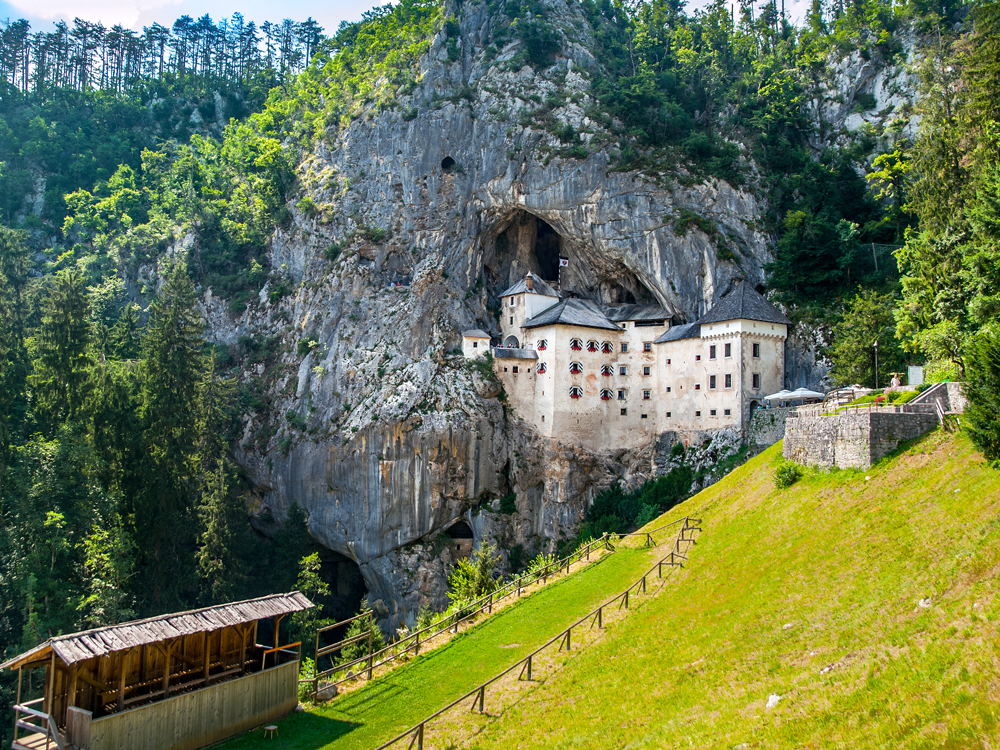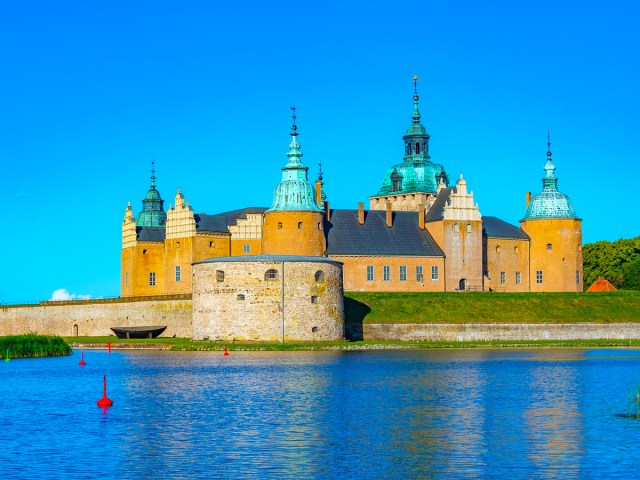If you love visiting castles, there’s no shortage of options in Europe. But you may have already crossed many of the most famous European castles off your bucket list. For starters, there’s Germany’s Neuschwanstein Castle, which inspired Walt Disney to build Cinderella’s Castle at Disney, and England’s Windsor Castle, which has housed British royalty since the 11th century. But there are many palaces in Europe that considerably fewer travelers visit. From a castle built inside of cave to one of Europe’s few remaining circular castles, discover five underrated European castles with fascinating histories.
Predjama Castle – Slovenia

Largest castle built into a cave entrance? There’s a Guinness World Record for that. Welcome to Predjama Castle, located about 40 miles southwest of Slovenia’s capital, Ljubljana. Built about halfway up a 400-foot cliff face, this Gothic fortress dates back to 1202, but the majority of the current, Renaissance-style facade was built in the 16th century. The castle (and its secret tunnel to the outside world) was once a famous hiding spot for Erazem Lueger, a doomed robber baron who was wanted for killing a relative of Frederick III.
Today, the castle is a museum that makes up part of the Postojnska Park Complex. Castle tours usher guests through four stories of rooms — including the chapel, kitchen, bedroom, dungeon, and armory, where a collection of weapon replicas is still kept. The fortress also has its famous fans: Jackie Chan shot part of his 1986 film Armour of God here, and George R.R. Martin, the author whose books inspired Game of Thrones, deemed the 115-foot-tall castle “amazing.” Try to visit in July, when Predjama Castle and its namesake village are the backdrop for Erazem’s Knight Tournament, one of Europe’s most popular medieval festivals.
Kalmar Castle – Sweden

Fortress, distillery, granary, prison: This Swedish castle has worn many hats since its construction more than 800 years ago. Stretching across two islands on Kalmar Sound — which separates mainland Sweden from the island of Öland in the Småland province — the medieval castle has been a pivotal location in Scandinavian history, but it began life in the waning years of the Viking age as a single tower fortified to defend the area from pirates and other marauders along the Baltic Coast.
Captured, recaptured, burnt, and rebuilt, the site of both massacres and peace treaties, the current castle is now a beautifully restored example of Renaissance architecture. A succession of royalty expanded and remodeled the original tower, adding a curtain wall, corner towers, gatehouses, and a moat. The enchanting castle is now a popular museum, as well as home to one of the country’s largest and most festive Christmas markets.
Kaunas Castle – Lithuania

Located in Kaunas — Lithuania’s second-largest city — at the confluence of the Nemunas and Neris rivers, the remains of this magnificent gothic edifice date to the 14th century. Originally built to defend against crusaders, it was one of the first stone castles in the country and the only one with two rows of defensive walls. But as the city’s center shifted and the defensive outpost became less essential in subsequent centuries, it was converted into a jail before falling into ruins. In the 20th century, the local government undertook restoration efforts and archeological excavations, and today, what’s left of the castle is an illuminating museum that often hosts cultural events.
Thanks to its once-strategic location, the castle sits near another fascinating historical site — the Kanaus Fortress. In the 18th and 19th centuries, a network of fortresses in and around the city was constructed to protect the Russian Empire from Germany at the dawn of World War I. The brick buildings and subterranean fortresses — some unfinished — were built near rail lines and within grassy hillsides, and housed batteries, warehouses, hospitals, churches, barracks, and administrative buildings. However, the Kaunas Fortress was no match for the tools of modern warfare, and the structures were breached. Today, the surviving buildings are in disrepair or have been converted to museums, housing, and hotels.
Bellver Castle – Mallorca, Spain

Bellver Castle was built in the early 1300s — back when Mallorca, the largest of the Balearic Islands off the coast of eastern Spain, was still an independent kingdom — but it didn’t last long as the intended royal residence for King Jaume II. After the kingdom fell to Aragon in 1344, the Gothic castle became a prison on and off for the next six centuries. And unfortunately for the inmates detained there, the views from the cells were the opposite of what the site has since come to be known for: the best panorama in Palma, the capital of the island.
With a name derived from the words for “beautiful view,” Bellver is worth visiting for the hilltop views of Mallorca and its turquoise waters alone, whether you take them in on a guided tour or solo stroll. But as one of Europe’s few circular castles still standing (the only one in Spain) and the home of the Palma’s City History Museum, Bellver rightfully draws plenty of architecture and history buffs, too.
Krujë Castle – Albania

Albania, with its beachy Adriatic coastline and stunning inland mountains, has long been attractive to others. Throughout its early history, the small Balkan country was alternately ruled by the Illyrians, the Greeks, and the Romans, among other civilizations. Sometime in the fifth or sixth century CE — perhaps as a stronghold against Barbarian invaders — Krujë Castle was erected in hills above Albania’s then-capital city of Krujë.
In the 15th century, as the castle became a citadel against the aggressively encroaching Ottoman Empire, a noble-born Albanian who had been kidnapped and educated by the Ottomans, Gjergj Kastrioti Skënderbej (now simply called Skanderbeg), gathered an army in Krujë Castle and successfully defended the area for 25 years. However, the castle finally fell to the Turks in 1478, 10 years after Skanderbeg’s death, and Albania remained part of the Ottoman Empire until 1912.
The castle, now in a suspended state of ruin, is still a popular attraction in the hills above Tirana, the modern capital. Unsurprisingly, Skanderbeg is hailed as a heroic figure in Albania, and a museum dedicated to him opened inside the castle walls in 1982. Also inside the castle walls are the sacred ruins of a Sufi mosque and its graveyard, as well as an ethnographic museum.
More from our network
Daily Passport is part of Inbox Studio, which publishes content that uplifts, informs, and inspires.
















